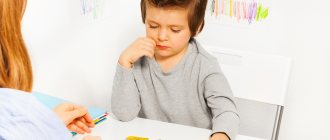Stages of child speech development
Trajectories of speech development are individual for each child, and therefore psychologists and other specialists in the field of early development do not establish clear standards for speech development in children. It is important to note that an indicator of speech development is not only the number of sounds and words that a child uses to communicate, but also his passive vocabulary, that is, those words that the child understands. Speech skills characteristic of the conditional norm in early and junior preschool age are presented in the table.
| Age | Speech development |
| 1-3 months | Scream. |
| 3-6 months | Humming – drawn-out sounds (“a-gu”, “a-gy”, “bu-u”, etc.). |
| 4-5 months | Squealing, laughter. Humming in various intonations. |
| 6 months | Babbling (syllables “ma”, “ba”). |
| 7-8 months | Increasing the number of pronounced sounds, onomatopoeia (“woof-woof”, “pee-pee”), understanding simple words and requests. |
| 9-11 months | Simple words (“mother”, “baba”, “give”, “na”). |
| 1–1.5 years | Simple two-word phrases (“give yum-yum”, “there’s a pussy there”). |
| 2-3 years | Phrases of 2-3 words, the appearance of question words. Naming famous colors, objects, body parts. Learning simple poems, telling short stories. |
| 34 years | Phrases of 4 or more words. A stranger can understand a child’s speech. |
If there is a strong discrepancy between the child’s speech development level and age norms, it is advisable to seek advice from a specialist (neurologist, speech therapist, psychologist) in order to exclude a delay in psycho-speech development. Don't put it off until later.
Symptoms
By what signs can you determine that your baby is lagging behind in speech development? The first symptoms may appear up to a year, but most parents rarely pay attention to minor delays in the baby’s verbal development. Precursors of RRD in infancy may be:
- inexpressive cry or its absence;
- late period of humming, insufficient intonation of sounds;
- late appearance of babbling or its absence, the baby cannot pronounce the same sounds for a long time;
- babbling is not an independent type of verbal activity, that is, the baby does not use it to communicate with others;
- long period of use of “babbling” words;
- lack of imitative actions of adults.
The main symptom of RDD is the late appearance of the first words and simple phrases. For such children, the first words may appear only by the age of 2, and a simple phrase by the age of 3. But they speak unclearly, and those around them have difficulty understanding them. At three years old, a child cannot construct sentences and use them to communicate with others. To communicate, the baby mostly uses facial expressions and gestures.
In addition to speech symptoms, children with mental retardation may also have neurological symptoms:
- hyperactivity or, conversely, the child is too slow;
- the baby has difficulty adapting to new conditions;
- does not make contact with others;
- subject selectivity in play and selectivity in communication;
- motor lag;
- unstable attention.
If the described symptoms occur, it is necessary to carry out a comprehensive diagnosis, which will help determine the exact cause of the defect. And then choose effective ways of correction.
How does speech development delay manifest itself?
Delayed speech development (DSD) is a pathology characterized by a violation of the timing of the appearance of speech, a reduced vocabulary, and defects in sound pronunciation and grammatical structure of speech. Symptoms of delayed speech or mental development of a child may include the following:
- Problems with chewing and swallowing food;
- Constantly open mouth, excessive salivation;
- Refusal to communicate;
- Lack of eye contact;
- Slurred speech, “porridge in the mouth”;
- Difficulties in understanding speech (does not respond to requests);
- Inappropriate behavior.
Experts distinguish three degrees of ZRR:
- Mild degree of RRD – absence of pathologies of the nervous system. Violations of the emotional-volitional sphere are possible.
- Moderate degree of mental retardation - a delay in speech development is combined with lesions of the nervous system. Such children may experience tremors, paralysis of the organs of articulation, tics, as well as various disturbances in the functioning of mental processes.
- Severe degree of mental retardation is typical for children with lesions of the speech areas of the brain. In this case, there are serious difficulties in mastering speech in combination with disorders of memory, attention, thinking, and voluntary regulation (self-control).
Timely contact with specialists allows you to identify the cause of the child’s delayed speech development as early as possible and develop an individual plan for correctional and developmental classes.
Depending on the degree of mental retardation, an individual route of correctional work is determined. Children with severe speech development disorders require long-term support from various specialists.
Speech is the most important component of a child’s mental development, the formation of which occurs in the first years of life [1]. For a child, it is the most important means of communication with the outside world, the basis for obtaining information for the development of cognitive activity and thinking.
The communicative function of speech contributes to the development of communication skills, which is of great importance for the formation of adaptive behavior, the emotional-volitional sphere and the personality of the child. The cognitive function of speech is closely related to the communicative function. The regulatory function of speech develops by the age of 4-5 years, when the child’s semantic side of speech is sufficiently developed. The formation of this function is closely related to the development of internal speech, regulation and control of behavior and intellectual activity.
Development of speech skills is normal
For timely diagnosis of speech disorders in children, it is necessary to take into account the patterns of normal speech development. Children pronounce their first words by the end of the 1st year of life, but they begin to train their speech apparatus much earlier, already from the first months of life, so the age of up to one year is a preparatory period in the development of speech. The sequence in the development of pre-speech reactions is as follows: hooting, humming - 1.5-3 months; “pipe” (chains of different sounds) - 4-6 months; babbling - 6-7 months; babbling words and modulated babbling - 8-11 months.
In the 1st year of life, the child’s speech apparatus is preparing to pronounce sounds. The listed speech reactions are a kind of game for the baby and give the child pleasure; for many minutes he can repeat the same sound, thus training in the articulation of speech sounds. At the same time, the active formation of speech understanding occurs.
An important indicator of speech development up to one and a half to two years is not so much the pronunciation itself, but the understanding of addressed speech (receptive speech). The child must listen carefully and with interest to adults, understand spoken speech well, recognize the names of many objects, and follow simple everyday requests and instructions. In the 2nd year of life, words and sound combinations already become a means of verbal communication, i.e. expressive speech is formed.
Main indicators of normal speech development from 1 year to 4 years:
- appearance of clear, meaningful speech (words) - 9-18 months;
- at first (up to 1.5 years) the child mainly learns to understand speech, and from 1.5-2 years he quickly develops active speech and his vocabulary grows. The number of words that the baby understands (passive vocabulary) is still greater than those that he can pronounce (active vocabulary);
- the appearance of phrases of two words - 1.5-2 years, of three words - 2-2.5 years, of 4 or more words - 3-4 years;
- volume of active vocabulary: by the age of 1.5 years, children pronounce 5-20 words; 2 years - up to 150-300 words; 3 years - up to 800-1000 words; 4 years - up to 2000 words.
Disorders of speech development affect the overall development of children’s personality, their intellectual development and behavior, and make it difficult to learn and communicate with others [1–3].
Specific language development disorders (SDLDs) include disorders in which normal language development is affected in the early stages. In ICD-10 [4], these include developmental disorders of expressive language (F 80.1) and receptive language (F 80.2). In this case, disturbances appear without a previous period of normal speech development. SRDD is the most common mental development disorder; its frequency in the pediatric population is 5–10% [2, 5]. Let's consider the main types of speech development disorders.
Main forms and causes of development of speech disorders
Alalia
(according to modern international terminology “
dysphasia
” or “
developmental dysphasia
”) is a systemic underdevelopment of speech, it is based on an insufficient level of development of the speech centers of the cerebral cortex, which can be congenital or acquired in the early stages of ontogenesis, in the pre-speech period. At the same time, in children, expressive speech is characterized primarily by significant deviations, while speech understanding may vary, but, in general, it is much better developed [2, 3]. The most common variants (expressive and mixed expressive-receptive disorders) are manifested by a significant delay in the development of expressive speech compared to the development of understanding.
In modern literature, both terms (DSRD and “developmental dysphasia”) are used. But “developmental dysphasia” is considered a more accurate formulation of the diagnosis, since this term reflects both the neurological and developmental-age aspects of this disorder [3, 6].
Complete or partial loss of speech caused by local lesions of the speech areas of the cerebral cortex is called aphasia
. Aphasia is the collapse of already formed speech functions, so this diagnosis is made only after 3-4 years. With aphasia, there is a complete or partial loss of the ability to speak or understand spoken speech.
Dysarthria
- violation of the sound-pronunciation aspect of speech as a result of disruption of the innervation of the speech muscles. Depending on the location of the lesion in the central nervous system, several variants of dysarthria are distinguished: pseudobulbar, bulbar, subcortical, cerebellar.
Speech formation is an individual process that depends on many factors. The decisive period is from the 1st year of life to 3-5 years, when the central nervous system and its functions intensively develop. At the same time, the child’s speech is formed under the stimulating influence of the speech of adults and depends to a great extent on sufficient speech practice, a normal speech environment, upbringing and training.
The causes of delays in speech development may be perinatal lesions of the central nervous system, dysfunction of the articulatory apparatus, damage to the organ of hearing, a general lag in the mental development of the child, the influence of heredity and unfavorable social factors. Difficulties in mastering speech are also found in children with retarded physical development, those who suffered serious illnesses at an early age, those who are weakened, or who receive malnutrition.
Hearing impairment is a common cause of isolated speech delay [7]. Even moderate and gradually developing hearing loss can lead to delays in speech development. Signs of hearing loss in a baby include a lack of response to sound signals and an inability to imitate sounds, while in an older child there is excessive use of gestures and close observation of the movements of the lips of speaking people. However, the assessment of hearing based on the study of behavioral reactions is subjective. Therefore, if partial or complete hearing loss is suspected in a child with isolated speech delay, an audiological examination is indicated. The method of recording auditory evoked potentials also provides reliable results.
The rate of delay in speech development is due to a lack of stimulation of speech development, the influence of unfavorable intrafamily factors (insufficient communication and education). The social environment stimulates speech development and provides a speech pattern. In families with poor speech impulses, children begin to speak late and speak little. A delay in their speech development may be accompanied by a delay in other areas of development, while their natural abilities are normal.
Delayed speech development in a child may also be caused by autism [8] or general mental retardation. In these cases, an in-depth examination by a child psychiatrist is indicated. In developmental dysphasia, the primary deficit is speech impairment, and intellectual disability and limited knowledge observed in patients at different age periods are secondary. It is this feature that distinguishes patients with dysphasia from children with mental retardation, which is characterized by incomplete formation of all higher mental functions and intellectual abilities.
Motor alalia (dysphasia).
The cause of motor alalia is a dysfunction of the speech motor analyzer (motor center of speech). The child has difficulty organizing speech movements and their coordination, therefore speech development is delayed [9]. Speech understanding is not impaired. Independent speech either does not develop for a long time or remains at the level of individual sounds and words. Parents, noting silence, characterize children as understanding spoken speech, but not wanting to speak. Instead of speech, children tend to use facial expressions and gestures, especially in emotionally charged situations. The first words and phrases appear late. Parents note that, in addition to speech delays, in general, children develop normally. As their vocabulary increases, children's difficulties in mastering word structure become more noticeable. Speech is slow, impoverished, vocabulary is limited to everyday topics. There are many slips of the tongue (paraphasias), permutations, and perseverations in speech. Growing up, children understand these mistakes and try to correct them [9].
Sensory alalia (dysphasia). This form of delayed speech development is based on disorders of speech understanding, which is associated with dysfunction of the speech-hearing analyzer (sensory speech center). This leads to disorders in the analysis and synthesis of speech signals, as a result of which connections are not formed between the sound image of a word and the object or action it denotes. The degree of underdevelopment of the speech-hearing analyzer can be different. In more severe cases, the child does not understand the speech of others at all, treats it as noise devoid of meaning, and does not even react to his own name. In other cases, he understands individual words, but loses them against the background of a detailed statement. When addressed to him, he does not catch all words and their shades, so he may react to them incorrectly. Often children look into the face of the speaker, which helps improve speech understanding due to reinforcement from the visual analyzer - “reading from the face.” Sometimes a child understands only one person—the mother, the teacher [9].
When pronouncing words, numerous errors in stress, sound substitutions, and distortions are made, the nature of which often changes. The child learns new words and phrases slowly. His statements are imprecise and difficult to understand. He is not critical of his own speech. There are incoherent repetitions of all words known to the child (logorrhea), repetitions of words and phrases (echolalia), while the words are not comprehended and not remembered. In general, the speech of a child with sensory alalia can be characterized as increased speech activity against the background of impaired understanding of the speech of others and insufficient control over one’s own speech [9].
Sensory alalia in its pure form is much less common than motor alalia; sensory alalia accompanies motor alalia much more often. In these cases we speak of motor alalia with a sensory component. The existence of mixed forms of alalia indicates a close functional connection between the speech-motor and speech-auditory analyzers. A thorough examination of a child with alalia makes it possible to clarify the nature of the disorders and determine the optimal approaches to their correction.
Neurobiological factors in the pathogenesis of speech development disorders
Perinatal pathology of the central nervous system plays an important role in the formation of speech disorders in children. It is in the perinatal period that the most significant events occur that have a direct and indirect impact on the processes of the structural and functional organization of the central nervous system. Taking this into account, it is advisable to identify risk groups for disorders of psycho-speech development already in the 1st year of life [10]. The high-risk group should include children in whom, in the first 3 months of life, as a result of a clinical and instrumental examination, structural changes in the central nervous system were identified, premature babies (especially with extremely low body weight), children with disorders of the auditory and visual analyzers, insufficiency of the functions of cranial nerves (in particular, V, VII, IX, X, XII), children with delayed reduction of unconditioned automatisms, long-lasting disorders of muscle tone [10].
In premature newborns, especially those with a short gestation period, an important period of development of the central nervous system (interneuronal organization and intensive myelination) occurs not in utero, but in difficult conditions of postnatal adaptation. The duration of this period can vary from 2-3 weeks to 2-3 months, and it is often accompanied by the development of various infectious and somatic complications. This may serve as an additional factor causing disturbances in psychomotor and speech development in immature and premature children. Hearing impairment, one of the main consequences of prematurity, also plays a negative role [10, 11]. Studies have shown that approximately half of very premature children have delayed speech development, and at school age - learning difficulties, problems with reading and writing, concentration and behavior control [12].
In recent years, the role of genetic factors in the formation of speech development disorders has attracted attention. The role of hereditary predisposition is confirmed by the high frequency of intrafamilial occurrence of speech development disorders [2]. Among the genes that can determine delayed speech development, FOXP 2
on chromosome 7q31.
It is believed that FOXP2
simultaneously controls both the acquisition and application of grammatical language rules and speech motor skills - movements of the muscles of the tongue, lips, and larynx.
There are familial and sporadic cases of expressive language disorders caused by mutations in the FOXP2
[13].
The number of genes that can determine delayed speech development also includes FOXP 1
(on chromosome 3p14),
CNTNAP 2
(7q36),
ATP 2 C 2
(16q24),
CMIP
(16q24)
SETBP 1
(18q12.3),
NRXN 1
(2p13.3),
TM 4 SF 20
(2q36.3) ,
SRPX 2
(Xq22.1),
KIAA 0319
(6p22.2) [13, 14]. Attention should be paid to the multiple influences of these genes on the processes of formation of various brain structures and functions, which reflects the close connection in the formation of speech and other higher mental functions. Identification of genetic risk factors is important because it will potentially allow us to identify the biological pathways and brain mechanisms that are involved in the processes of language acquisition and play a key role in the etiology of speech development disorders. In addition, studying the identified genetic factors will provide an opportunity to unravel the complex relationships between language impairment and other related developmental disorders.
Thus, speech development disorders in children may be based on neurobiological factors, including early organic damage to the central nervous system due to perinatal pathology and hereditary predisposition, which can be combined in some patients.
Age dynamics and outcomes of speech development disorders
By school age, the outcomes of developmental dysphasia remain insufficiently studied. C. Miniscalco et al. [15] conducted a longitudinal study that included 25 children (18 boys, 7 girls) with moderate or severe manifestations of dysphasia at the age of 30 months. By the age of 6-7 years in this group of children, 6 people had no neuropsychic disorders, while the rest were diagnosed with attention deficit hyperactivity disorder (ADHD) (11 children), dyslexia (4), high-functioning autism (5) , developmental dyspraxia (7), borderline level of intellectual development (6), mental retardation (2) (the sum exceeds 25, since in some cases the children had several diagnoses).
We conducted [16] a retrospective study of the neuropsychological development of children with developmental dysphasia and its outcomes by primary school age. We examined 110 children, 87 boys and 23 girls, with a diagnosis of developmental dysphasia (or expressive speech development disorder - F80.1 according to ICD-10 [4]) established at the age of 3-4 years and 1-2 levels of general speech underdevelopment (GSD). ). All of them underwent repeated clinical, neurological and psychological examinations on an outpatient basis at the age of 7-9 years. Children whose speech development delay was caused by hearing loss, severe mental retardation, severe somatic or congenital endocrine pathology, malnutrition, as well as the influence of unfavorable social factors (insufficient communication and education) were excluded from the study group. The absence of any psychoneurological abnormalities by the age of 7-9 was established in only 8 (7.3%) people. Most often, the following pathological conditions were diagnosed, accompanied by significant difficulties in school learning: ADHD - in 39 (35.5%) patients, disorders of the development of written speech (dyslexia and dysgraphia) - in 15 (13.6%), dyslalia with OHP 3- 1st level - in 13 (11.8%).
A number of patients were under dynamic supervision of a neurologist with diagnoses such as cerebrasthenic syndrome - 8 (7.3%), autonomic dysfunction syndrome with frequent headaches - 6 (5.5%), chronic motor tics - 6 (5.5%) , nocturnal enuresis - 3 (2.7%). In 7 (6.3%) patients with an initial diagnosis of dysphasia, autistic disorders were confirmed during further follow-up, including childhood autism (2 children) and high-functioning autism (5 children). In some cases, patients continued to be observed with diagnoses such as mental retardation (mild mental retardation) (3), epilepsy (1), schizotypal disorder (1).
Thus, manifestations of developmental dysphasia at an early age can serve as harbingers of a number of psychoneurological disorders, the formation of the clinical picture of which passes through the OPD stage: dyslexia and dysgraphia, ADHD, autism [16]. In other cases, developmental dysphasia may be caused by perinatal damage to the central nervous system, the consequences of which are not completely overcome by primary school age, even with positive dynamics in speech development (dyslalia with OHP level 3, cerebrasthenic syndrome, autonomic dysfunction syndrome with frequent headaches, chronic motor tics , nocturnal enuresis) [16].
Early signs of trouble in speech formation
Speech acquisition is one of the main indicators of a child’s mental development. Children who do not try to speak at 2-2.5 years should be a cause for concern. However, parents may notice certain prerequisites for problems in speech development earlier [1]. In the first year of life, one should be alarmed by the absence or weak expression at appropriate times of humming, babbling, first words, reaction to adult speech and interest in it; at 1 year - the child does not understand frequently used words and does not imitate speech sounds, does not respond to addressed speech, and resorts only to crying to attract attention to himself; in the 2nd year - lack of interest in speech activity, growth of passive and active vocabulary, the appearance of phrases, inability to understand the simplest questions and show an image in a picture.
At 3-4 years of life, the following manifestations should cause high alertness: the child does not turn to adults with questions or for help, does not use speech. Vocabulary is limited; he cannot name objects known to him. Doesn't answer simple questions. The child’s speech is incomprehensible to others and he tries to supplement it with gestures, or shows indifference to whether other people understand him. The child has no desire to repeat words and phrases after adults, or he does it reluctantly.
As a screening method for identifying delays in speech development, parents can be asked a number of special questions to which the answers are “yes” or “no” (Tables 1 and 2). All questions are divided into two groups and characterize the formation of impressive and expressive speech: 1. Speech perception and hearing (hereinafter referred to as speech understanding), 2. Vocal and expressive reactions (hereinafter referred to as speech expressive reactions). Interpretation: all answers are “yes”: the child’s speech develops normally, hearing is not impaired; 1-2 answers “no”: you need to consult a specialist (doctor, speech therapist), and also have your hearing examined.
Table 1. Screening assessment of pre-speech development in children of the 1st year of life
Table 2. Screening assessment of speech development in children from the 2nd year of life to 5 years
Treatment
Speech underdevelopment due to dysphasia (alalia) is quite profound and requires not only changes in educational conditions, but also the help of specialists in the form of consultations or regular classes. Correction takes a long time and requires a lot of effort. If special measures are not taken, the process of speech acquisition will not only be delayed in time, but will begin to take on a distorted character.
The main directions of correction for speech formation disorders in children are complex interventions: speech therapy, psychological-pedagogical, psychotherapeutic assistance to the child and his family, as well as drug treatment (in the form of repeated courses of nootropic drugs). Of particular importance when organizing assistance to such children is the continuity of work with children by specialists in various fields (doctors, speech therapists, psychologists, teachers). Planning and implementation of corrective measures should be carried out according to individual plans for each child.
Timely use of nootropic drugs contributes to the most complete correction of speech development disorders. In groups of children with developmental dysphasia who received a course of monotherapy with nootropic drugs for 2 months, a significant improvement in indicators of expressive and impressive speech, as well as speech attention, was achieved [17]. The volume of the active vocabulary increased by 3.1-3.5 times, the number of spoken phrases - by 3.3-5 times, while in the control group - only by 1.5 times. It should be noted that the influence of nootropic drugs was multidirectional, helping not only to overcome speech development disorders in children, but also difficulties in the cognitive sphere, contacts with others, and social adaptation. According to the results of a parent survey, children showed a decrease in cerebrasthenic and psychosomatic disorders, motor clumsiness, hyperactivity, and improved attention, emotional control and behavioral characteristics [17].
A promising direction in drug therapy for dysphasia is the use of peptidergic nootropic drugs, in particular the domestic drug Cortexin. This drug contains a complex of water-soluble polypeptide fractions with a molecular weight of no more than 10,000 Da, easily penetrates the blood-brain barrier, and has a multimodal tissue-specific effect on the central nervous system. Studies have proven the neuroprotective effect of the drug - influence on the cascade regulation of apoptosis, prevention of the formation of free radicals and lipid peroxidation products, restoration of ATP levels in mitochondria [18, 19]. In the treatment of dysphasia, the most important aspects of its action are its positive effect on the mechanisms of neuroplasticity and neuroreparation (activates neuronal peptides and neurotrophic factors; optimizes the balance of metabolism of excitatory and inhibitory amino acids, dopamine, serotonin; has a GABAergic effect; helps improve the bioelectrical activity of the brain) [ 20, 21].
L.S. Chutko et al. [22] studied the effectiveness of Cortexin in the treatment of SRRR. 75 children were examined, divided into two subgroups. For the treatment of children in the main group (48 people), Cortexin was used intramuscularly at a dose of 0.5 mg/kg for children weighing up to 20 kg and 10 mg for children weighing 20 kg or more. The treatment course consisted of 10 injections once every other day in the morning. The duration of the course was 20 days. In the comparison group (27 patients), encephabol was administered orally in the form of a suspension (containing 20 mg of the active substance in 1 ml) at a dosage of 12-15 mg/kg/day in two doses (morning and afternoon) for 30 days. In the subgroup of children with developmental disorders of predominantly expressive speech, positive dynamics after treatment with Cortexin were observed in 19 (65.5%) cases. After treatment, the children began to use their vocabulary more actively, the grammatical structure of speech improved, and there was an increase in the number of syllables in repeated phrases. In the subgroup with a developmental disorder of predominantly receptive speech, positive dynamics were noted in 4 (57.1%) cases; children from this group showed a noticeable improvement in their understanding of addressed speech. After therapy with Cortexin, positive dynamics of EEG parameters were recorded in patients. In general, the results of the study indicate the high effectiveness of Cortexin in the treatment of SRRD with a predominance of both expressive and expressive-expressive speech disorders, which makes it possible to recommend it in the complex rehabilitation of children with speech development disorders [22].
I.I. Ogorodova et al. [23] assessed the effectiveness of correction of speech disorders in 93 children aged 3 to 7 years, among whom 12.9% had level 2 SLD, 87.1% of children had level 3 SLD. The majority of children (85%) also had ADHD, cerebrasthenic syndrome, and emotional-volitional disorders. Patients of the main group ( n
=48) as part of complex therapy for 10 days received intramuscular injections of cortexin at a dose of 0.5 mg/kg/day for body weights up to 20 kg and 10 mg for body weights over 20 kg.
Indicators of psychospeech development improved in 81.5% ( n
=39) of children from the group treated with Cortexin, compared to the control group - 46.6% (
n
=21). With Cortexin therapy, a more stable recovery of speech functions (sound pronunciation, vocabulary, grammar) and regression of neurological symptoms were noted.
When carrying out complex correction, positive dynamics can be observed in children with dysphasia; they consistently move from one level of speech development to another, higher one, and acquire new speech skills and abilities. It is well known that correctional assistance provided during the sensitive age period for speech formation, from 2.5 to 5 years, is effective, when speech function is actively developing. Therefore, it should be noted that the earlier problems in the development of a child’s speech are noticed and specialists begin to work with him, the better the results achieved will be, since the reserve capabilities of the child’s developing brain are highest in the first years of life.
Causes and diagnosis of speech delay
If you suspect that your baby has a delay in speech development, you should definitely seek specialized help. The following specialists will help you most accurately determine the causes of RRD:
- Pediatrician (assessment of the child’s overall development);
- Neurologist (study of the state of the brain, gross and fine motor skills);
- Otolaryngologist (hearing test);
- Psychologist (assessment of the level of mental development);
- Speech therapist (examination of articulation organs, diagnostics of the level of speech understanding, study of vocabulary, sound pronunciation, grammatical structure of speech, phrasal speech).
- In some cases, additional examination by a defectologist, audiologist, orthodontist, or psychiatrist may be required.
The reasons for delayed speech development may be the following:
- Biological causes: birth injuries, prematurity, minimal brain dysfunction, inflammatory diseases (encephalitis, meningitis), increased intracranial pressure, hearing diseases, heredity.
- Psychological reasons: lack of communication, overprotection, poor environment, and so on.
Methods for diagnosing pathology
Diagnosis is approached in a comprehensive manner. This means that a small patient is examined by different specialists - a pediatrician, an otolaryngologist, a neurologist, a speech therapist. In addition to collecting an anamnesis, examining and assessing the child’s health, he is sent for hardware diagnostics. This is necessary because, against the background of ZPRD, organic matter changes, in particular, the work of the left hemisphere of the brain, which is responsible for the development of speech, is disrupted. Therefore, the final diagnosis is made based on the results of examinations - EEG, computed tomography, evoked potentials technique.
After diagnosis, comprehensive treatment begins. A neurologist, psychologist, speech therapist, and reflexologist take part in it. Parents play a huge role - without them it is impossible to achieve success.
Correction of mental retardation in children
Methods for correcting and treating speech delay depend on the cause of the disorder and are established by specialists after diagnostic examinations. In some cases, doctors prescribe medication and massages. We will tell you in general terms about how to help your child learn to speak at home. These classes will be a good addition to working with specialists.
- Verbal communication with loved ones. Communication leads to development. Playing together with adults, emotional intimacy is something without which the harmonious development of the baby is impossible. Try to ask your child questions more often, encourage dialogue and joint exploration of the world.
- Exploring the world around us. It is necessary to support the child’s cognitive interest in every possible way, develop observation, thinking and imagination. To help your child develop a holistic picture of the world, walk with your child more often, talk and ask questions, read books, play, and conduct experiments.
- Development of auditory perception. Auditory perception makes it possible to understand speech, recognize various sounds of nature, household noises and hear music. An example of an exercise from this category is the game “Whose Sound?” An adult hides behind a screen and uses objects to make various sounds: rustling a bag, tearing paper, knocking with spoons, ringing a bell, pouring water, and so on. The baby must guess which object each sound corresponds to.
Regularity and consistency are important in speech development. When working with your baby at home, start by practicing simple skills and only when they are accessible to the baby, then move on to more complex exercises.
- Breathing exercises. The formation of speech breathing is the most important stage in the development of coherent and correct speech in a preschooler. The most effective way to develop it in preschool children is breathing exercises, which contribute to the formation of a smooth and sufficiently long exhalation and practice of pronouncing sounds and syllables. You can read more about breathing exercises in one of our previous articles.
- Articulation gymnastics. Speech or articulation gymnastics promotes the development of speech organs. Your baby will definitely enjoy these fun exercises and will help him learn to pronounce sounds correctly.
- Finger games are a unique way to develop a baby. They are a kind of massage and gymnastics for the fingers and toes. The movements are usually accompanied by short, funny poems, and children repeat them with pleasure. For kids, finger games are an independent activity, and for older preschoolers they can become a warm-up between exercises.
- Development of fine motor skills: playing with water and bulk materials, modeling, appliqué, drawing, lacing and much more. Choose games that your child likes, because pleasure from the process also plays an important role in the development of the baby.
Treatment of speech delay (SRR, ZPRR) in the center of Dr. Leviticus
In the clinic of Dr. Lev Levit, a safe proprietary method of craniocerebral stimulation (from the Latin cranium - skull, cerebrum - brain) is used to treat speech delay. This method is aimed at improving biochemical processes in the brain lobes responsible for speech activity and communication.
The traditional approach to the treatment of delayed speech and psycho-speech development includes:
- speech therapy classes
- massage for motor development, speech therapy massage
- electroreflexotherapy
- drug treatment (nootropics, stimulants, neurotransmitters, etc.)
Drug treatment is not used at the center. Correction, speech training and speech therapy sessions with the child are not carried out during the course. However, after a course of treatment, children themselves begin to make progress in their speech, because the procedures affect the root cause of the delay in speech development.
With subsequent speech therapy correction and activities with the child, such children quickly overcome delayed speech development and are no different from their peers.
The technique of craniocerebral stimulation is aimed at improving the functioning of those parts of the brain that do not function well enough. In the case of mental retardation, the child’s speech activity improves.
The method circulates cerebrospinal fluid and, as a result, metabolism also improves in children with speech problems and general retardation.
conclusions
Speech development is a complex process, and it occurs differently for each child. If the baby is healthy, speech development occurs naturally when you communicate with him and talk about the world around him. Your child watches you and tries to copy your speech, so it is important to monitor the correctness of your own speech. It is necessary to create a favorable environment for the child in which he can fulfill the needs characteristic of his age. You can offer your child games to develop fine motor skills, as well as introduce them to articulation and finger gymnastics. If you feel that your baby is experiencing difficulties and the development of his speech is far behind the conventional boundaries of the norm, you must definitely consult with specialists to rule out health problems and delayed speech development.
Short description
SRR is a lag in speech ontogenesis from the norm. Such children can speak, but their speech differs significantly from the speech of their peers. A speech therapist makes this diagnosis if the child does not have the required volume of words. ZRD can affect the development of higher mental functions, which will lead to a lag in overall development.
There are three periods when children’s speech develops more actively:
- up to 2 years – at this stage, prerequisites for the appearance of SRD may arise;
- up to 3 years - during this period, a speech therapist can diagnose a delay in mastering speech;
- up to 7 years - if corrective work to eliminate the defect has not been started and carried out, more serious speech disorders appear, for example, dysarthria.
According to recent studies, the number of children with developmental disorders has increased. To accurately determine the cause of RRD, it is necessary to conduct a comprehensive examination.
What to do if a child speaks poorly?
First, take the situation for granted. Don't be offended by facts. The faster help is provided, the higher the child’s chances of catching up with his peers at school. Secondly, get tested. The child must be examined:
- ENT;
- speech pathologist;
- neurologist;
- psychologist.
Some specialists may recommend undergoing additional examinations. This must be done in order to understand what exactly is preventing the child from developing in accordance with the norms, and to prescribe the correct treatment.
Causes of ZPRR
ZPRD occurs due to organic damage to brain structures and various disorders of the nervous system. Factors provoking delayed psycho-speech development:
- genetic diseases associated with disorders of the subcortex of the brain;
- infectious diseases and lack of oxygen during pregnancy;
- problematic birth (trauma, umbilical cord entanglement, rapid or premature birth, hypoxia);
- metabolic disorders in the central nervous system;
- organic brain damage (fluid accumulation, high intracranial pressure, tumors);
- pathologies of the psychiatric spectrum, including epilepsy;
- severe infectious diseases at an early age.
In addition to organic reasons, psychological factors also play an important role. Mental trauma and improper upbringing (overprotection, abuse, insufficient care and attention) can lead to developmental delays or complete loss of speech (mutism, speech negativism).









